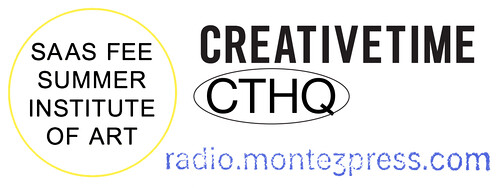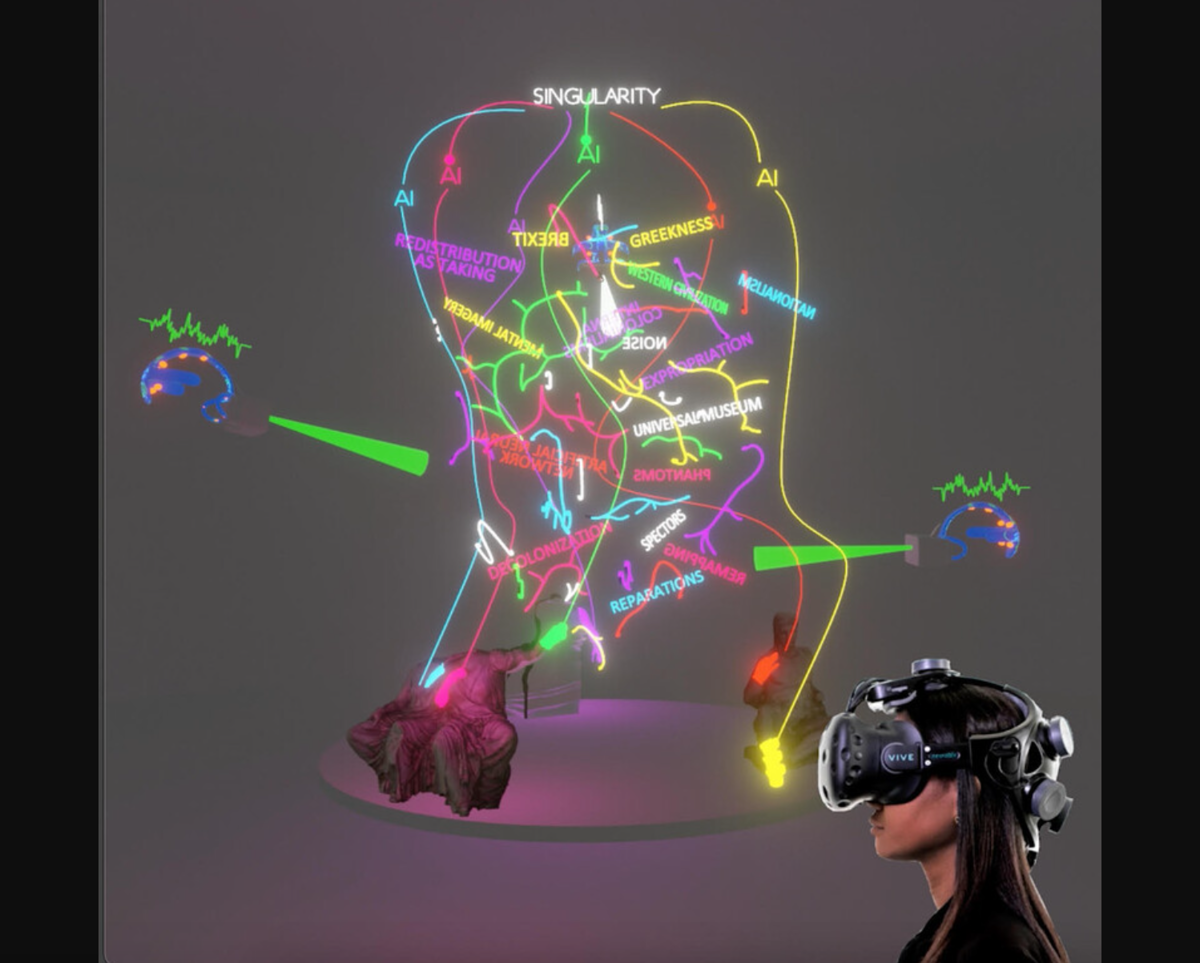This year’s Saas-Fee Summer Institute of Art, “Art, Apparatus and Neural-Digital Entanglement in Cognitive Capitalism,” has been organized in collaboration with CTHQ, Creative Time’s gathering space for art and politics, and Montez Press Radio, an experimental broadcasting and performance platform, in New York City. This program will map the history of artistic forms of resistance beginning with photography, through cinema, video, and other digital technics, in order to find clues on how to combat the threats that may result from new neural and brain-based technologies at our doorstep. We will throw a wide net around notions of the mind, brain and consciousness of our time, in order to capture the contemporary discourse and consider potential new forms of practical insurgency.
In “What Is an Apparatus?” and Other Essays (2006), Giorgio Agamben defines an apparatus as a kind of network established between “a heterogeneous set that includes virtually anything, linguistic and nonlinguistic, under the same heading: discourses, institutions, buildings, laws, police measures, philosophical propositions and so on.” Additionally, he describes the apparatus as always having a “concrete strategic function” that “appears at the intersection of power relations and relations of knowledge.” The proletariat working on the assembly line producing material objects has transitioned to the cognitariat swiping screens to produce data. Digital capturing apparatuses directed at our emotions, creativity and mental capacities have joined and subsumed the analog dispositifs focused upon the working body and its surplus value already in play. This collected data (or ‘big data’) sold to corporate, policing, and military clients is not passive or without repercussions. For example, Wendy Hui Kyong Chun has shown the ways that ideology is embedded in software. Could the same biases and forms of subsumption already present in digitality be carried over into these proposed neural-digital applications?
Just as the early theorists of cognitive capitalism realized the coming digital economy would create a crisis for labor and the production of subjectivity, so too another crisis is brewing exemplified by neural-based apparatuses that focus upon the brain’s variation and plasticity as a locus for capitalist speculation. OpenAI and Neuralink are just two examples of corporations already producing these technologies. While large language model-based chatbots such as ChatGPT are predicted to take over the majority of cognitive labor, deep learning text-to-image generators such DALL-E are equally poisoning the epistemological well and making many creative practices obsolete. As described by Slavoj Žižek in Hegel in a Wired Brain (2020), the “‘Wired brain’ refers to a direct link between our mental processes and a digital machine, a link which, while it enables me to directly trigger events in reality with a mere thought…also enables the digital machine to control my thoughts.” In other words, if a brainwave can be decoded to aid a paraplegic person to direct a cursor on a screen to move a robotic arm, then certainly in ten years the reverse will be true; electrical impulses designed to mimic brain waves emanating from an external machinic entity could penetrate the skull to redirect neural patterns in the brain.
As Frantz Fanon wrote in Black Skin, White Masks (1952), there is phylogeny (evolution), ontogeny (development), and also sociogeny; we are born biologically human but we can only experience ourselves in the context of sociological and linguistic structures. As Sylvia Wynter states in Towards the Sociogenic Principle (2001), “in the case of the human species, the sociogenic principle, as the information-encoding organizational principle of each culture’ s criterion of being/non-being, that functions to artificially activate the neurochemistry of the reward and punishment pathway, doing so in the terms needed to institute the human subjects as a culture-specific and thereby verbally defined, if physiologically implemented, mode of being and sense of self.” This is even more true for the becoming neural plastic brain in which sociologic and linguistic techne also engage in shaping the brain’s architectonics, or what Bernard Stiegler calls instrumental maieutics. This process is still ongoing in relation to a plethora of new apparatuses in which not only are more and more external relations digitally-mediated, but the very structure of deep learning networks are based upon the anatomy and physiology of the biological brain to process information.
While this model of the brain can be increasingly understood as a neural-digital entanglement, the emancipatory capacities of these technologies and their social cultural import also cannot be denied. Artists, curators and theorists have also produced a network of cultural dispositions based on their own emancipatory procedures and elaborations that have kept pace and pushed back against this evolution of despotic techne. Harun Farocki’s concept of operational images, or image data created by machines for machine usage in which human agency disappears, as developed in Eye Machine I-III (2001-2003), will be especially important to our discussion, while the analysis of 3D and IMax films, virtual reality and artificial neural networks will help us generate new understandings of sensation, perception and cognition in relation to viewer identification, subjectivity and ideology. Additionally, we will look to the work of Issac Julien and others to understand the power of decolonizing and queering cinematic apparatuses to alter historical narrations.
Faculty
Defne Ayas, Davide Balula, Suparna Choudhury, Stephanie Dinkins, Thyrza Goodeve, Lyle Ashton Harris, Isaac Julien, Liz Magic Laser, Reza Negarestani, Warren Neidich (founder/director), Alison Nguyen, Diane Severin Nguyen, Barry Schwabsky (co-director), Martha Schwendener, Mindy Seu, Anuradha Vikram, and more to be announced.
Applications
Applications for SFSIA 2024 NYC are open to students, practitioners and scholars from the fields of art (including video, photography, installation and multimedia), ecology, science and technology studies, philosophy, design, architecture, critical theory, cultural studies, film and media studies, and beyond. Please see our application for more information.
About SFSIA
Saas-Fee Summer Institute of Art (SFSIA) is a nomadic, intensive summer academy with shifting programs in contemporary critical theory that stresses an interdisciplinary approach to understanding the relationship between art and politics. SFSIA originated in Saas-Fee, Switzerland in 2015 and then migrated to Berlin, Germany where it has been hosted by Import Projects (2016) and Spike (2017-2019). Additional programs have been hosted by Otis College of Art and Design in Los Angeles, Performance Space New York, The Brooklyn Rail, and sonsbeek20→24 in Arnhem, The Netherlands. SFSIA was founded and is directed by Warren Neidich and is co-directed by Barry Schwabsky. Sarrita Hunn is the assistant director.
About CTHQ
CTHQ is Creative Time’s gathering space supporting artists working at the intersection of art and politics as they continue to plot, orchestrate, and recharge from cultural, political and social organizing work. CTHQ sits within Creative Time’s historic and ongoing work to gather artists to share tactics for political change most notably through the Creative Time Summit, Creative Time Reports, and its Global Fellowship. Growing within a lineage of visionary and transgressive creative moments, CTHQ serves as a hub for today and tomorrow’s community of socially engaged and politically oriented artists in the neighborhood, citywide, across the country, and around the world.
About Montez Press Radio
Montez Press Radio is an experimental broadcasting and performance platform. Founded in 2018 with the goal of fostering greater discourse and interaction between artists, writers, and thinkers through the medium of radio, MPR invites different corners of the art world to connect with each other in person and on air—a place where media finally meets flesh. We’re drawn to art that exists in the unexpected, the authenticity of sharing without a script, the sounds of ideas in the making, conversation that forgets there’s an audience. Stop by when we’re live at 46 Canal Street in NYC or look at the upcoming schedule to see if we’re off-site and broadcasting near you.
Please see our website or contact info [at] sfsia.art for more information.



